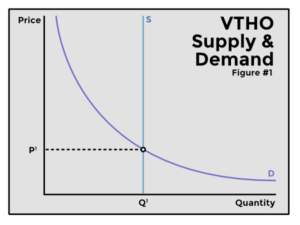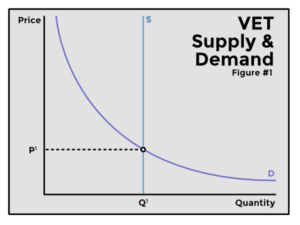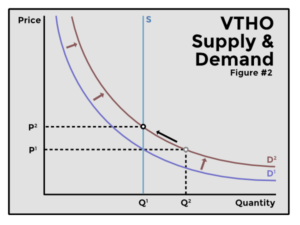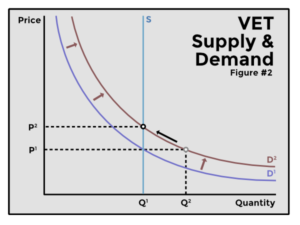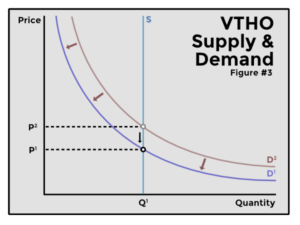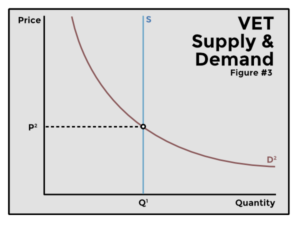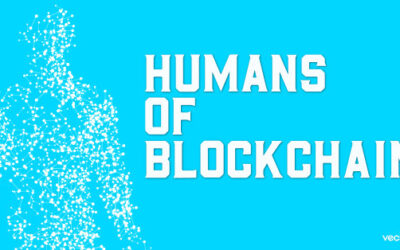The Dual–Token Model, Tokenomics, and Basic Supply & Demand
In this article, we aim to provide investors with more knowledge regarding the economic model behind VeChain’s ecosystem. We will focus on a few main topics:
- Why is there a separate gas token – VTHO?
- How can VeChain scale without having demand increase the cost of transactions?
- How will the VET token increase in value over time?
The Dual-Token Model
The VeChainThor blockchain uses what is called a ‘dual-token’ system. There are two tokens:

VET – VeChain Token
VET is the primary token of the blockchain and it has several uses. VET’s main functions are to distribute the network, store and transfer value, and generate a secondary token, VTHO. Each VET generates VTHO at a rate of .000432 VTHO per day. There is no minimum limit on what generates VTHO, even holding just one VET in a wallet will generate VTHO. Some users like to “stake” larger amounts of VET in nodes in order to speed up their VTHO generation rate.
Note: If you store VET on an exchange like Oceanex the VTHO distribution is weekly. For other exchanges please double check if and when VTHO gets distributed.

VTHO – VeThor Token
VTHO is the ‘energy’ or ‘gas’ token of the blockchain. When making transactions, a small amount of VTHO must be paid as a transaction cost. Enterprises and developers using the blockchain must also use VTHO to upload data and create smart contracts. VTHO can be purchased on several exchanges, but everyone who holds VET automatically generates some VTHO, creating a form of passive income for VET holders that they can either use or sell on the open market. For every transaction, 70% of the VTHO paid gets destroyed. The other 30% gets rewarded to the authority node that verified the corresponding block.
This guide explained the underlying economic model of VeChain.
To find out approximately how much VTHO you can generate using VET, check out this handy calculator from VeChainstats.com.
Open VeChainstats.com in new window
At first, this dual-token system might seem a bit unnecessary. Why don’t they just use the main token (VET) to pay transaction costs, like Bitcoin and Ethereum?
The main reason is to solve a major scalability issue in traditional blockchains. As token prices increase, transaction fees become more expensive. Network congestion causes fees to increase further, making the single-token blockchain model even more expensive and inconvenient to use. VeChain’s dual-token model provides a stable business environment where fluctuations in the prices of digital assets won’t dramatically effect the cost of using the network, making it the ideal public blockchain for enterprise use.
VTHO Supply & Demand Models
Now that we’ve discussed the dual-token system, we can look at what causes demand for both the VET and VTHO token to rise. The VeChain platform will have many users – which we can cover in a later guide.
These users of the VeChainThor blockchain will have to use VTHO for everything they do on the network. Since some of them (mostly businesses and third-party apps) need more VTHO than they can produce with VET, they are going to buy the VTHO from others. You can imagine what will happen when there are a lot of people who are trying to buy VTHO: the price will go up. This results in the paradox we see in single-token blockchains:
Problem:
Higher usage results in a shrinking VTHO supply, a higher VTHO valuation, and increased transaction costs. This will lower the amount of users willing or able to use the blockchain.
Solution:
The VeChain Foundation and Steering Committee is able to adjust variables such as reducing the minimum amount of VTHO needed for a transaction (currently 21) and increasing the generation rate of VTHO per VET (currently 0.000432 per VET per day). This allows the market for VTHO to stay in an equilibrium, resulting in stable transaction costs: exactly what enterprises and developers want.
In this manner, we can see how increased usage will lead to excess demand for VTHO causing two scenarios:
Scenario A
The minimum VTHO needed for a transaction is turned down to reflect the increased price of VTHO on the open market.
The VTHO generation rate is turned up, allowing market price to stabilize, but increasing the passive income of VET holders.
As more companies and applications use VeChain, we will most likely see the following cycle that demonstrates the role the foundation plays in maintaining stable transaction costs:
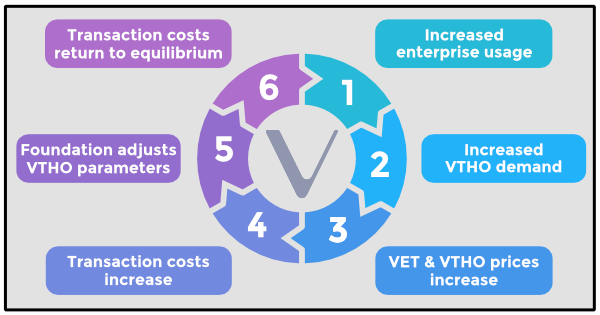
Let’s take a look at daily supply and demand from an economic point of view:
In market equilibrium, the price of both VTHO and VET is P1 at quantity Q1
When VeChain’s blockchain gets used more, VTHO demand increases to Q2, causing a shift right in the demand curve. Price increases to P2. As the price of VTHO rises, VET demand also increases to Q2, causing the VET price to also increase to P2.
Foundation adjusts parameters, causing the VTHO demand curve to shift back to its original place. Market returns to equilibrium. VET price remains unaffected due to its increased value: 1 VET can now pay for more transactions compared to before.
Conclusion
This guide explained the underlying economic model of VeChain.
- Thanks to the dual-token system, transaction costs will not significantly increase when VeChain gets used more.
- When demand for VTHO increases, the Foundation can simply alter some variables to bring the market back to equilibrium. For enterprises, this feature makes VeChain much more reliable than other blockchains.
- As demand for VTHO increases, demand for VET will also increase. As the VeChainThor blockchain gets used more, the price of VET will increase thanks to the tokenomics of the blockchain.
So when will all this become a reality? Each day the sum total of all VTHO produced is around 37 million. With the recent spike in mainnet traffic, on busy days VeChain is already coming close to eclipsing that. With more and more projects being developed, many are optimistic that increased demand will happen sooner rather than later.
Contributors
This guide was compiled by Reza Enayatizaman & Ben Yorke.

